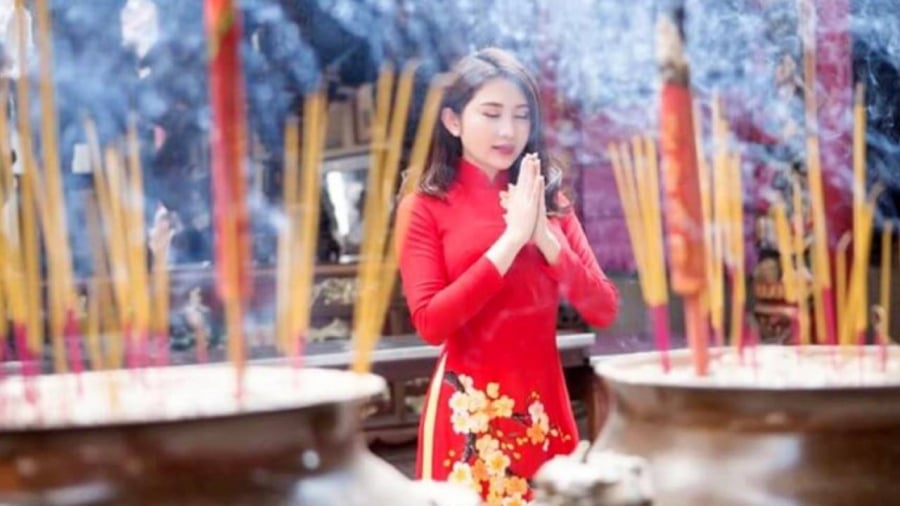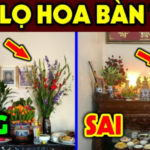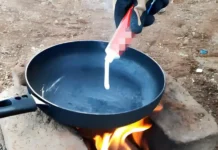According to the book “Traditional Vietnamese Ancestral Worship” edited and revised by Venerable Thich Thanh Due, Deputy Head of the Vietnam Buddhist Academy, published by the Ministry of Culture and Information, the pagoda is not only a place to worship the Buddha but also serves as a communal spiritual gathering place for the Vietnamese people from ancient times to the present, with immense significance.
According to the traditional customs of the Vietnamese people, on full moon days, the first day of the lunar month, and important festival days, people often visit the pagoda to pray and ask for the boundless karmic power of the Buddha and Bodhisattvas and other holy beings to receive blessings such as good health, long life, protection from misfortunes, elimination of obstacles, prosperity in family and happiness.

There are regulations that must be followed when preparing to visit the pagoda:
When making offerings at the pagoda, only vegetarian offerings such as incense, fresh flowers, ripe fruits, vegetarian dishes, sticky rice… should be prepared. Salted offerings such as livestock (buffalo, goat, pig), meat, chicken, sausages… should not be prepared.
Salted offerings are only accepted if there are shrines to the Holy Beings or Ancestors within the pagoda and they are only offered there. They should not be placed on the main altar, which is the main shrine of the pagoda.
On the main altar, only vegetarian offerings should be placed, such as vegetables, fruits, and simple offerings like chicken, sausages, pork, and betel. These offerings are usually placed at the shrine or the pagoda’s own altar of the Dharma Protector – the deity who manages all the affairs of a pagoda.
Do not prepare gold or silver, or paper money for offering to the Buddha at the pagoda. If you want to make these offerings, they should be placed on the altar of the deities, ancestors, or the ancestral altar.
Paper money or forbidden items should not be placed on the main altar. However, money, gold, and merit should be put in the merit box at the pagoda.
Flowers for Buddha’s worship are lotus flowers, lilies, single flowers, water lilies… Do not use miscellaneous or wild flowers.
Before the day of offering to Buddha at the pagoda, follow a vegetarian diet and observe good daily practices such as vegetarian meals, abstaining from indulgences, and doing good deeds.
During this period, people usually prepare additional characteristic offerings such as crafted items resembling everyday objects: hats, clothes, vehicles… but do not prepare offerings resembling human shapes. In addition, there are offerings for sentient beings such as lotus seed porridge, corn, rice cakes, potatoes… All offerings should be placed on the shrine of the Buddha, not on other altars or the main altar.
For “ban khoan” or “cầu siêu” ceremonies, specific instructions from the monastery should be followed.
5 steps in the ritual when visiting the pagoda:
1. Prepare offerings: Light incense and make offerings to the Master Buddha first.
2. After making offerings to the Master Buddha, place offerings on the main altar, light candles, ring the bell three times, and then make offerings to the Buddha and Bodhisattvas.
3. After making offerings on the main altar, go and light incense at all other altars in the pagoda. When lighting incense, perform three or five prostrations. If a pagoda has shrines to Mother Goddesses, Bridal Spirit, then make offerings and pray according to your wishes.
4. Finally, offer worship at the Ancestral Altar (Ancestor House).
5. At the end of the ceremony, after paying homage, it is advisable to visit the monastery’s male or guest room to inquire about the well-being of the monks and abbots and to perform additional merits as desired.
Which pagodas should you visit at the beginning of the year?
If you are unsure which pagoda to visit at the beginning of the Year of the Serpent in 2024 to receive the New Year’s divination, offer offerings for overcoming obstacles, seek fortunate blessings and peace, and pray for wealth and health for your family, consider the following 11 most sacred pagodas for your visit during Tet 2024:
1. Bai Dinh Pagoda (Ninh Binh)
2. Tran Temple (Nam Dinh)
3. Ba Vang Pagoda (Quang Ninh)
4. Ba Chua Kho Temple (Bac Ninh)
5. Thac Bo Deity Temple (Hoa Binh)
6. Truc Lam Zen Monastery (Vinh Phuc)
7. Ong Hoang Bay Temple (Lao Cai)
8. Yen Tu Pagoda (Quang Ninh)
9. Dong Dang and Mau Son Temple (Lang Son)
10. Phuc Khanh Pagoda (Hanoi)
11. Ngoc Hoang Pagoda, Ho Chi Minh City


































